|
NATIONAL PARK SERVICE
Atlantic and Gulf Coasts Recreation Area Survey |

|
UNDEVELOPED SEASHORE AREAS IN TEXAS
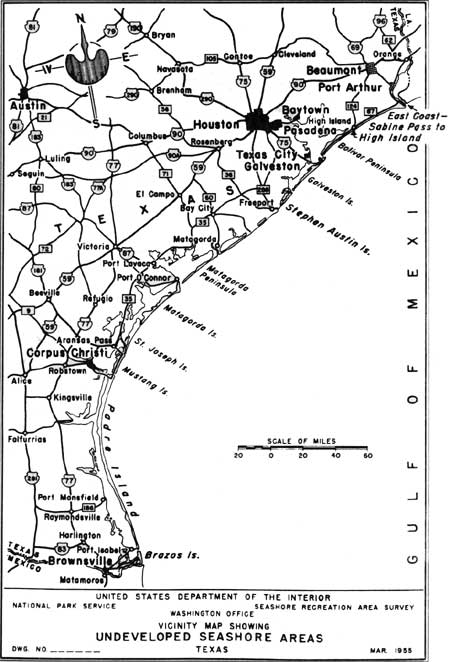
|
| Undeveloped Seashore Areas of Texas (Vicinity Map) (click on image for an enlargement in a new window) |
East Coast-Sabine Pass to High Island
Texas
| Location: | From Sabine Pass to High Island, Texas. |
| Accessibility: | By paved road. |
| Description of Area: | A 37-mile stretch of low, slightly rolling coastline, this area contains generally stable sand dunes and little vegetation. The beach varies in width from 100 to 200 feet, and in character from much silt, shells and debris to a clearer, cleaner span for bathing. There are also indications of erosion at various points along the coast. The slope of the beach and foreshore varies from moderate to gentle. |
| Present Use: | Ranching and the drilling for gas and oil are the principal industries. State Highway 87 parallels the coast. |
| Analysis: | The eastern sector of this area is the least desirable because of silting conditions and the immense amount of shells and debris on the beach. The western sector is worthy of consideration as a potential public seashore area. |
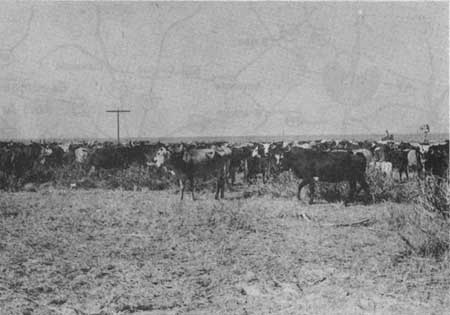
|
| Cattle round-up along Coastal Highway |
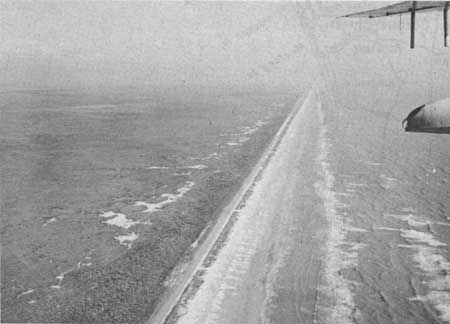
|
| Coastal Highway & Beach |
Galveston Island
Texas
| Location: | Off mainland, southwest of Galveston, Texas. |
| Accessibility: | By U. S. Highway 75, Gulf coast and Santa Fe rail lines and by ferry. |
| Description of Area: | This island is 12 miles in length and from 1 to 2 miles wide. The beach is flat, from 200 to 300 feet wide; the sand is fine, hard and light-colored. The dunes are low, irregular, and generally unstable. Vegetative cover consists of grasses, sedges, croton, rushes and juniper. The area is of considerable historical interest. |
| Present Use: | Much of the island serves as pasture land for ranching; a great number of small tracts of land are held in individual ownerships. |
| Analysis: | Expansion of municipal beach facilities will apparently be westward on the island. An express highway from Houston places this rapidly growing city within easy travel distance of the beach. The area will probably serve best as a metropolitan or a regional recreational site. |

|
| Galveston Island |
Stephen Austin Island
Texas
| Location: | The peninsula lies northeast of Brazos River and the city of Freeport, and southwest of Galveston Island. |
| Accessibility: | By car over hard-packed sand from mainland bridge. |
| Description of Area: | This portion of a 15-mile long peninsula is typical of the region but not outstanding. The beach, 9 miles long, is wide and the slope gentle. Portions of it are littered with shells and debris. In general, the sand is fine, clean and hard-packed. The land elevation is low, and the dunes are less than 6 feet in height and unstable. The plant life is limited to grasses and sedges with some scattered herbs and a few clumps of juniper shrubs. |
| Present Use: | The first 5 miles of the peninsula are developed as a resort center. The San Luis Beach Island Development Company is subdividing and developing the remaining 9 miles of the peninsula for private occupancy. |
| Analysis: | Certain portions of the peninsula now being subdivided would make excellent public seashore recreation areas. The State of Texas is negotiating with. Mr. F. B. Cassidy, of the San Luis Beach Island Development Company, for the use of some of these properties for this purpose. |

|
| Stephen Austin Island |
Matagorda Peninsula
Texas
| Location: | Offshore, southeast of Matagorda, about midway between Galveston and Corpus Christi, Texas. |
| Accessibility: | By County Highway 2301. |
| Description of Area: | A 21-mile-long, narrow, offshore sand barrier, low in elevation. The beach is narrow and steep; the sand is coarse, light and loose-packed. Considerable litter and great drifts of seashells are found above high-tide level, and the low sand dunes are unstable and irregular. Grass is the primary vegetative cover with no native trees or shrubs. |
| Present Use: | There are scattered ranch developments and herds of cattle. The State is now negotiating for some land east of the Colorado River for park purposes. |
| Analysis: |
This is one of the least attractive of the
undeveloped Texas coastal areas because of the poor quality of its
beaches, dunes, vegetative cover and offshore waters. The State is negotiating for a portion of the peninsula for State park purposes. It is believed unnecessary to give further study to the area at this time. |
 
|
| Matagorda Peninsula |
Padre Island
Texas
| Location: | Between Corpus Christi and Port Isabel. |
| Accessibility: | Causeways at Corpus Christi and Port Isabel. |
| Description of Area: | An offshore bar or barrier-reef island, 117 miles in length, of which only 98 miles are here considered. It varies in width from less than one-eighth mile to not more than 3 miles. The foreshore area varies from 10 to 200 feet in width and from steep to gradual in slope. The offshore area is consistently gentle in slope and varies in width from 200 to 2,000 feet. The sand is fine in texture, light-colored, and fairly clean. The dunes vary from small mounds to 40 feet in height and are not entirely stabilized. Sea oats, croton and morning-glory are the three dominant types of vegetative cover to be found. Birdlife values are outstanding and historical values important. |
| Present Use: | The chief use of the island is for grazing, with some oil-drilling activity. There are developments and a county park at each causeway. |
| Analysis: | Its great size and remote character, endless sweep of broad beach, grass-topped dunes and windswept sand formations have great appeal. Its natural resources, historical and biological values should be preserved in public ownership. |
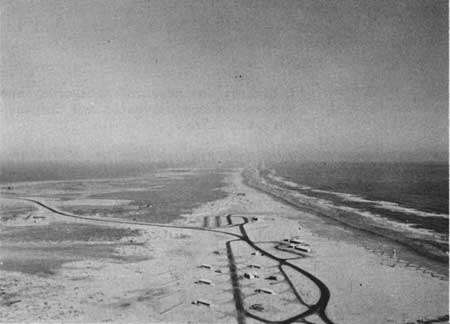
|
| Cameron County Park, Padre Island |

|
| Oil Rig, Padre Island |
Brazos Island
Texas
| Location: | Mouth of Rio Grande. |
| Accessibility: | By car over State Highway 4. |
| Description of Area: | The area is actually a peninsula 8 miles in length and averaging about three-quarters of a mile in width. The beach is wide, flat and clean along the northern portion. The sand is fine in texture and light in color. The water is clear and the shores moderately sloping. The dunes are 20 to 30 feet high and generally stable. The vegetative life consists primarily of sea oats, croton and morning-glory. Some portions of the southern 3 miles have been eroded by river and littoral currents. |
| Present Use: | A few scattered cottages and an oil well are the only developments. The island is popular with fishermen. |
| Analysis: | Because of its excellent beach, interesting dunes, ease of accessibility, and relatively undeveloped status, this area should be considered for public ownership. Its location at the mouth of the Rio Grande links the area with many outstanding events in the history of that great river. |
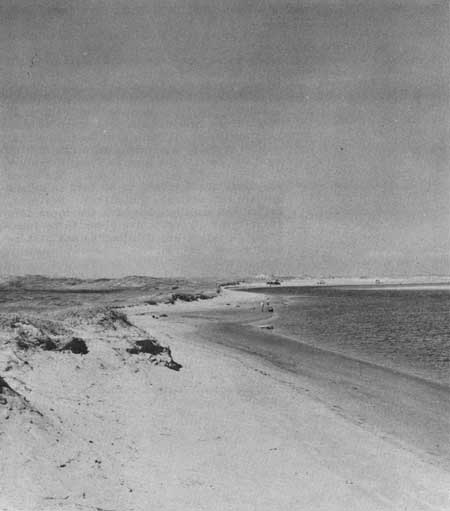
|
| Brazos Island, Near Mouth of Rio Grande |
Texas
Bolivar Peninsula
The peninsula is a western extension of the east coast of Texas running from High Island southwestwardly 28 miles to the Bolivar Roads waterway. It varies in width from 1/2 mile to more than 3-1/2 miles. In general, the peninsula is a low, slightly rolling, sandy plain. The vegetative cover is almost entirely grass, with few trees and shrubs. There is a long row of frontal dunes not more than 10 to 15 feet high and generally stable. The beach is wide (up to 200 feet), gently sloping and fairly clean. The foreshore and offshore areas also are gently sloping and quite clean. Ranching and drilling for oil are the principal industries. There are communities along the peninsula and the resort-vacation type of development is expanding. State Highway 87 traverses the peninsula and most of the usable land off this road is being developed by private interests. There are better locations along the Texas coast for the development of public seashore recreation areas.
Matagorda Island
The island lies between Cavallo Pass and Cedar Bayou, south of Port O'Connor on the mainland, and is accessible only by boat and plane. It is about 35 miles long and from 1-1/2 to 4-1/2 miles wide. The island possesses a wide, flat, clean beach and dunes that are quite high, extensive and generally stable. Vegetation consists of grassy plains and salt marshes. The Matagorda Air Force Base occupies the northern 14 miles of the island while the remainder is owned by Mr. Clint Murchison and is used generally for the grazing of cattle. Mr. Murchison maintains a residence on the island and has other ranch buildings. The island is not as desirable for public recreation purposes as some others along the Texas coast.

|
| Matagorda Island |
St. Joseph Island
This island presently connects with Matagorda Island at Cedar Bayou and runs 21 miles southwestwardly to Aransas Pass. It varies in width from less than a mile to nearly 5 miles. The island is very similar in character to Matagorda Island, with a wide, flat, clean beach, interesting dunes, and little vegetation. Mr. S. W. Richardson is purported to be the owner of the island and has built a large home in the southwestern portion. An airstrip and landing docks have been provided, and scattered throughout the island are ranch developments. Certain areas under consideration by the State have a higher value and better quality than St. Joseph Island, insofar as seashore recreation factors are concerned.
Mustang Island
From its northward end at Aransas Pass, Mustang Island extends southwardly to Corpus Christi Pass where it joins with Padre Island. It is 16-1/2 miles long and has an average width of 2 miles. The beach is wide, flat, and quite clean of debris and shells. The slope of the foreshore and offshore areas is gentle and regular for a great distance. The dunes are imposing, quite regular in size, and stable. The principal and predominant plants on the island are grasses. A few vines and low-growing shrubs are the only other native plants found growing on the island. A paved road extends the full length of the island and is accessible from the mainland at each end. Considerable development has taken place at both ends of the island and it is presumed that expansion will be toward the central undeveloped portion.
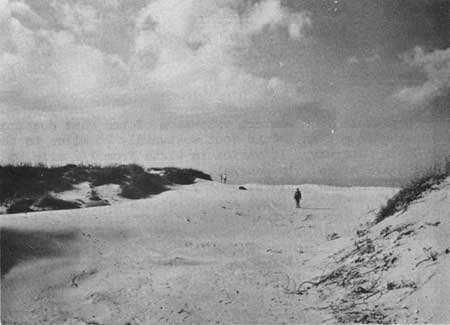 
|
| Mustang Island |
| <<< Previous | <<< Contents>>> | Next >>> |
rec_area_survey/ag/tx.htm
Last Updated: 25-Jun-2007